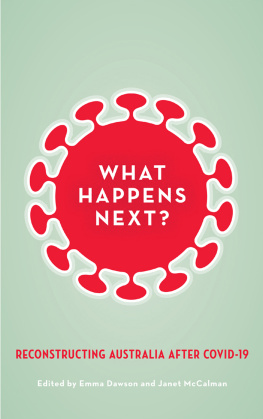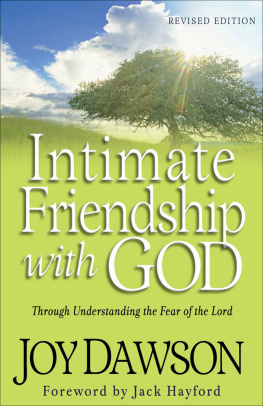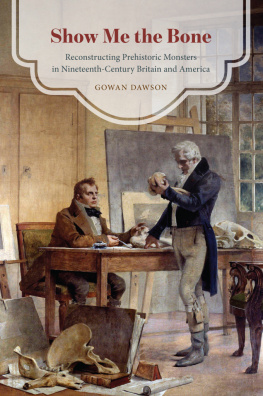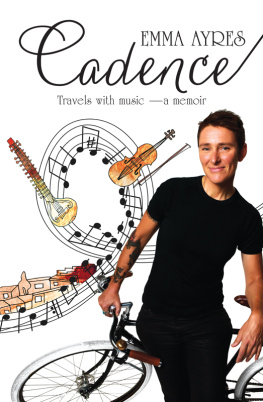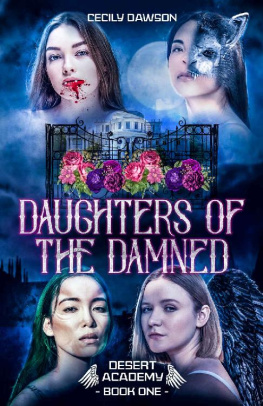RECONSTRUCTING AUSTRALIA AFTER COVID-19
Edited by Emma Dawson and Janet McCalman

MELBOURNE UNIVERSITY PRESS
An imprint of Melbourne University Publishing Limited
Level 1, 715 Swanston Street, Carlton, Victoria 3053, Australia
www.mup.com.au

First published 2020
Text remains with the individual contributors
Design and typography Melbourne University Publishing Limited, 2020
This book is copyright. Apart from any use permitted under the Copyright Act 1968 and subsequent amendments, no part may be reproduced, stored in a retrieval system or transmitted by any means or process whatsoever without the prior written permission of the publishers.
Every attempt has been made to locate the copyright holders for material quoted in this book. Any person or organisation that may have been overlooked or misattributed may contact the publisher.
Text design and typesetting by Typeskill
Cover design by Peter Long
Printed in Australia by McPhersons Printing Group

9780522877212 (paperback)
9780522877229 (ebook)
To our parents, for giving both of us our values, and to Iris, Katerina and Henry, for theirs is the future.
Contents
Professor Janet McCalman AC
Thomas Mayor
Professor Janet McCalman AC
Professor John Langmore AM
The Hon. Jenny Macklin
Professor Fiona Stanley AC & Dr Kate Lycett
Dr Jim Chalmers MP
Lachlan McCall
Dr Shireen Morris
The Hon. Jay Weatherill
Dr Liz Allen
Andrew Petersen
Michele ONeil
The Hon. Andrew Leigh MP
The Hon. Anthony Albanese MP
Emma Germano
Terri Butler MP
The Hon. Mark Butler MP
Emeritus Professor Roy Green
Professor Clinton Fernandes
Clare ONeil MP
Emma Dawson
Professor Rob Moodie, Dr Tasmyn Soller & Emeritus
Professor Mike Daube AO
Osmond Chiu
Dr John Falzon
Dr Elizabeth Hartnell-Young
Emeritus Professor Stephen Parker AO
Dr Julie Connolly
Peter Lewis
Emma Dawson
Introduction
Professor Janet McCalman AC
We must not waste this crisis, because the stakes could not be higher. What happens next will determine our health and wellbeing for generations.
COVID-19 is a terrible disease and an effective vaccine may take years. Modern medicine is very good at keeping people alive long enough for their immune systems to fight back, and death rates in countries with strong hospital systems are falling. Otherwise, all we have is prevention, and for prevention our most important tool is organised society. The quality of states around the world is now being measured in human lives lost. It is a brutal accounting.
The modern state owes its growth to public healtha political transformation that began in the midst of the cholera-pandemic years of the nineteenth century. Public health recognises that the individual is only safe if the society is safe: that the health of one depends on the health of all. It is no different with global warminglike the virus, the climate emergency threatens everyone.
And as COVID-19, like a heat-seeking missile, probes weaknesses in the body, its social determinantspoverty, crowding, insecurity, malnutrition, chronic disease and unfairnesscreate its richest human fuel. It relishes weak or corrupt states, even very rich ones, that have abdicated their duty of service to the people. It thrives on inequality and injustice.
But there are the causes of the causes, beyond the emergence of a novel coronavirus. These are the deep environmental stresses of exponential population growth and planetary exhaustion, fuelled by the fossil economy over the past 250 years. The climate emergency and the pandemic share a deep ancestry.
This deeper crisis will drive the emergence of other novel diseases that cross to humans from the natural world or from intensive livestock farming, just as it will trigger more natural disastersfires, droughts, floods and famine. Above all, the inequality of the world, both within nations and between them, is what places us at greatest risk.
The majority of urban workers in the world, including many in rich countries, depend on the daily exchange of goods, services and money. The precariat has replaced the proletariat, so that quarantining the market economy leaves people with only their government to fall back on. And as with cholera, if the poor get sick, then eventually so too will the rich.
This is the extent of the crisis. It goes beyond the pandemic and its immediate economic disruptions, as painful as they are. It has eaten into the deepest recesses of the human enterprise and exposed its vulnerabilities, even in a wealthy country like ours. And despite the risks of infection, people have been protesting around the world that Black Lives Matter and that inequality has gone too far. Perhaps this time, just perhaps, there will be change. There is much to be done.
What Happens Next? Reconstructing Australia after COVID-19 offers a rich cast of thinkers and doers from politics, economics, business, farming, governance, health, welfare, media, and education both higher and lower. No one has a complete recipe for recovery. Not all would agree with each other, but all offer insights and pathways to be explored. Neither are they pessimistic: indeed, when solutions can be imagined, there is hope.
One of the good things to emerge from Australias pandemic has been the explosion of discussion, webinars and talks as we Zoom across institutional, geographic and cultural borders. This national conversation must grow, and this book is a contribution to that. What matters is that we learn from each other, find some common ground, and focus on the reconstruction. The virus has delivered us a diagnosis. Now it is time for the recovery.
The recovery requires a national reconstructionmore than simply a rehabilitation to what we were. Since colonisation, the weeping sores that have never healed are those of racism and unfairness. We have never lived up to our ideals of the fair go for all, nor to the requirements of a constituted Commonwealth, founded for the common good.
The book begins with an invocation from Thomas Mayor of the promise of the Uluru Statement from the Hearta gift to the nation of reconciliation, a just rebuilding through a Makarrata. Such a reconciliation between First Nations and settler Australia could also lead the healing of the land and of society, teach us how to form partnerships instead of factions, and find consensus in place of conflict. This, we hope, is what will happen next.
PART 1
Reimagining Australia
Time to heal: Uluru healing the people and the land
Thomas Mayor
This entire continent, now called Australia, was once a Dreaming. A place where flora, fauna, humankind and the land itself, together, determined the values and laws of First Nations society. We had no need for printed tomes, because our Dreaming, far older than any European text, was handed down in oral traditions from generation to generation, from custodian to custodian, in stories and song as far back as the Ice Age.

